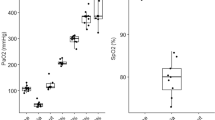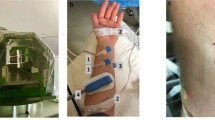Abstract
The venous–arterial difference in CO2 (ΔCO2) has been proposed as an index of the adequacy of tissue perfusion in shock states. We hypothesized that the variation in PaCO2 (hyper- or hypocapnia) could impact ΔCO2, partly through microcirculation adaptations. Fifteen healthy males volunteered to participate. For hypocapnia condition (hCO2), the subjects were asked to hyperventilate, while they were asked to breathe a gas mixture containing 8 % CO2 for hypercapnia condition (HCO2). The 2 conditions were randomly assigned. Blood gases were measured at baseline before each condition, and after 5–7 min of either hCO2 or HCO2 condition. Microcirculation was assessed by the muscle reoxygenation slope measured with near infrared spectroscopy following a vascular occlusion test and by skin circulation with in vivo reflectance confocal microscopy. ΔCO2 was significantly increased with hCO2 while it tended to decrease with HCO2 (non-significant). HCO2 induced a moderate increase of the resaturation slope of NIRS oxygenation. Skin microcirculatory blood flow significantly dropped with hCO2, while it remained unchanged with hypercapnia. Our results warrant cautious interpretation of ΔCO2 as an indicator of tissue perfusion during respiratory alkalosis.

Similar content being viewed by others
References
Shoemaker WC, Appel PL, Kram HB. Role of oxygen debt in the development of organ failure sepsis, and death in high-risk surgical patients. Chest. 1992;102(1):208–15.
Levy B, Gibot S, Franck P, Cravoisy A, Bollaert PE. Relation between muscle Na + K + ATPase activity and raised lactate concentrations in septic shock: a prospective study. Lancet. 2005;365(9462):871–5.
Perz S, Uhlig T, Kohl M, Bredle DL, Reinhart K, Bauer M, Kortgen A. Low and “supranormal” central venous oxygen saturation and markers of tissue hypoxia in cardiac surgery patients: a prospective observational study. Intensive Care Med. 2011;37(1):52–9.
Lamia B, Monnet X, Teboul JL. Meaning of arterio-venous PCO2 difference in circulatory shock. Minerva Anestesiol. 2006;72(6):597–604.
Danin PE, Siegenthaler N, Levraut J, Bernardin G, Dellamonica J, Bendjelid K. Monitoring CO2 in shock states. J Clin Monit Comput. 2015;29(5):591–600.
Vallet B, Teboul JL, Cain S, Curtis S. Venoarterial CO(2) difference during regional ischemic or hypoxic hypoxia. J Appl Physiol. 2000;89(4):1317–21.
Cuschieri J, Rivers EP, Donnino MW, Katilius M, Jacobsen G, Nguyen HB, Pamukov N, Horst HM. Central venous-arterial carbon dioxide difference as an indicator of cardiac index. Intensive Care Med. 2005;31(6):818–22.
Teboul JL, Mercat A, Lenique F, Berton C, Richard C. Value of the venous-arterial PCO2 gradient to reflect the oxygen supply to demand in humans: effects of dobutamine. Crit Care Med. 1998;26(6):1007–10.
Vallee F, Vallet B, Mathe O, Parraguette J, Mari A, Silva S, Samii K, Fourcade O, Genestal M. Central venous-to-arterial carbon dioxide difference: an additional target for goal-directed therapy in septic shock? Intensive Care Med. 2008;34(12):2218–25.
Morel J, Gergele L, Verveche D, Costes F, Auboyer C, Molliex S. Do fluctuations of PaCO2 impact on the venous-arterial carbon dioxide gradient? Crit Care. 2011;15(6):456.
Umeda A, Kawasaki K, Abe T, Watanabe M, Ishizaka A, Okada Y. Hyperventilation and finger exercise increase venous-arterial PCO2 and pH differences. Am J Emerg Med. 2008;26(9):975–80.
Myers DE, Anderson LD, Seifert RP, Ortner JP, Cooper CE, Beilman GJ, Mowlem JD. Noninvasive method for measuring local hemoglobin oxygen saturation in tissue using wide gap second derivative near-infrared spectroscopy. J Biomed Opt. 2005;10(3):340–57.
Cracowski JL, Minson CT, Salvat-Melis M, Halliwill JR. Methodological issues in the assessment of skin microvascular endothelial function in humans. Trends Pharmacol Sci. 2006;27(9):503–8.
Gomez H, Torres A, Polanco P, Kim HK, Zenker S, Puyana JC, Pinsky MR. Use of non-invasive NIRS during a vascular occlusion test to assess dynamic tissue O(2) saturation response. Intensive Care Med. 2008;34(9):1600–7.
Altintas MA, Altintas AA, Guggenheim M, Steiert AE, Aust MC, Niederbichler AD, Herold C, Vogt PM. Insight in human skin microcirculation using in vivo reflectance-mode confocal laser scanning microscopy. J Digit Imaging. 2010;23(4):475–81.
Cinotti E, Gergele L, Perrot JL, Domine A, Labeille B, Borelli P, Cambazard F. Quantification of capillary blood cell flow using reflectance confocal microscopy. Skin Res Technol. 2014;20(3):373–8.
Mayeur C, Campard S, Richard C, Teboul JL. Comparison of four different vascular occlusion tests for assessing reactive hyperemia using near-infrared spectroscopy. Crit Care Med. 2011;39(4):695–701.
Futier E, Robin E, Jabaudon M, Guerin R, Petit A, Bazin JE, Constantin JM, Vallet B. Central venous O(2) saturation and venous-to-arterial CO(2) difference as complementary tools for goal-directed therapy during high-risk surgery. Crit Care. 2010;14(5):R193.
Guzman JA, Kruse JA. Gut mucosal-arterial PCO2 gradient as an indicator of splanchnic perfusion during systemic hypo- and hypercapnia. Crit Care Med. 1999;27(12):2760–5.
Richardson DW, Wasserman AJ, Patterson JL. General and regional circulatory responses to change in blood pH and carbon dioxide tension. J Clin Invest. 1961;40:31–43.
Cullen DJ, Eger EI 2nd. Cardiovascular effects of carbon dioxide in man. Anesthesiology. 1974;41(4):345–9.
Mas A, Saura P, Joseph D, Blanch L, Baigorri F, Artigas A, Fernandez R. Effect of acute moderate changes in PaCO2 on global hemodynamics and gastric perfusion. Crit Care Med. 2000;28(2):360–5.
Khambatta HJ, Sullivan SF. Effects of respiratory alkalosis on oxygen consumption and oxygenation. Anesthesiology. 1973;38(1):53–8.
Curley G, Kavanagh BP, Laffey JG. Hypocapnia and the injured brain: more harm than benefit. Crit Care Med. 2010;38(5):1348–59.
Fujita Y, Sakai T, Ohsumi A, Takaori M. Effects of hypocapnia and hypercapnia on splanchnic circulation and hepatic function in the beagle. Anesth Analg. 1989;69(2):152–7.
Komori M, Takada K, Tomizawa Y, Nishiyama K, Kawamata M, Ozaki M. Permissive range of hypercapnia for improved peripheral microcirculation and cardiac output in rabbits. Crit Care Med. 2007;35(9):2171–5.
Winso O, Biber B, Martner J. Effects of hyperventilation and hypoventilation on stress-induced intestinal vasoconstriction. Acta Anaesthesiol Scand. 1985;29(7):726–32.
Gustafsson U, Sjoberg F, Lewis DH, Thorborg P. The effect of hypocapnia on skeletal muscle microcirculatory blood flow, oxygenation and pH. Int J Microcirc Clin Exp. 1993;12(2):131–41.
Dobson GP, Yamamoto E, Hochachka PW. Phosphofructokinase control in muscle: nature and reversal of pH-dependent ATP inhibition. Am J Physiol. 1986;250(2):71–6.
Slater RM, Symreng T, Ping ST, Starr J, Tatman D. The effect of respiratory alkalosis on oxygen consumption in anesthetized patients. J Clin Anesth. 1992;4(6):462–7.
Jubrias SA, Crowther GJ, Shankland EG, Gronka RK, Conley KE. Acidosis inhibits oxidative phosphorylation in contracting human skeletal muscle in vivo. J Physiol. 2003;553(2):589–99.
Vohwinkel CU, Lecuona E, Sun H, Sommer N, Vadasz I, Chandel NS, Sznajder JI. Elevated CO(2) levels cause mitochondrial dysfunction and impair cell proliferation. J Biol Chem. 2011;286(43):37067–76.
Zavorsky GS, Cao J, Mayo NE, Gabbay R, Murias JM. Arterial versus capillary blood gases: a meta-analysis. Respir Physiol Neurobiol. 2007;155(3):268–79.
Author information
Authors and Affiliations
Corresponding author
Ethics declarations
Conflicts of interest
None.
Rights and permissions
About this article
Cite this article
Morel, J., Gergelé, L., Dominé, A. et al. The venous–arterial difference in CO2 should be interpreted with caution in case of respiratory alkalosis in healthy volunteers. J Clin Monit Comput 31, 701–707 (2017). https://doi.org/10.1007/s10877-016-9897-6
Received:
Accepted:
Published:
Issue Date:
DOI: https://doi.org/10.1007/s10877-016-9897-6




